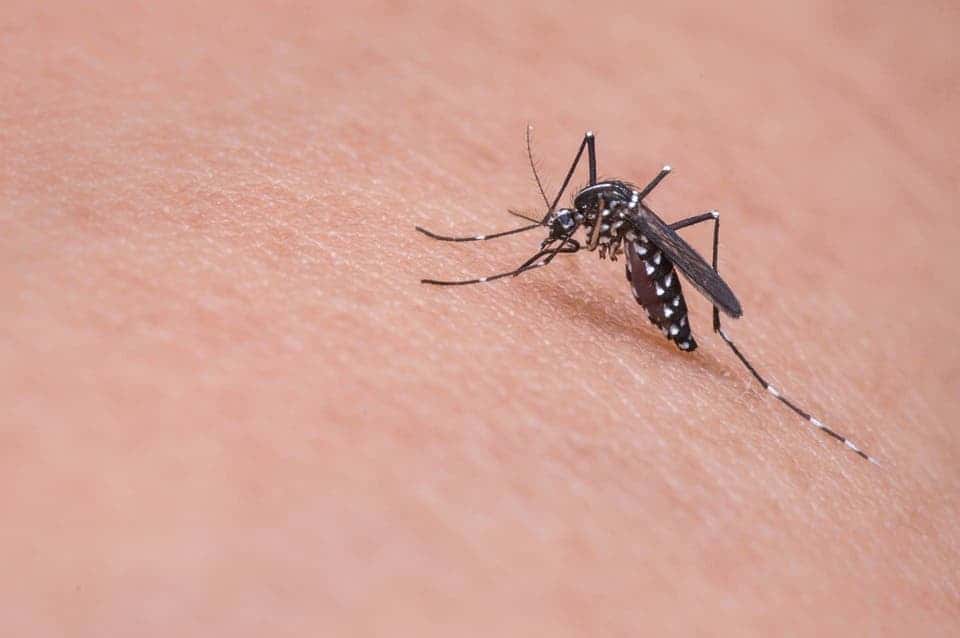Smelling is key if you’re a hungry female mosquito, a new study reports.

A team of researchers led by members from the University of Washington has looked at the brains of female mosquitoes in real-time to understand how they identify, track, and home in on their next meal. The process integrates information from the visual and olfactory sensory systems, they report. The insect’s olfactory system catches the scent of its target and triggers chemical changes in the brain of the female mosquito that makes her visually scan her surroundings for specific types of shapes and fly toward them.
Smell first, find targets later
“Our breath is just loaded with CO2,” said corresponding author Jeffrey Riffell, a UW professor of biology. “It’s a long-range attractant, which mosquitoes use to locate a potential host that could be more than 100 feet away.”
Only female mosquitoes feed on blood — the guys dine on pollen. However, this also means that only female mosquitoes bite people and spread diseases such as malaria. The present research comes as an effort from the team to better understand how the insects find their prey (or ‘hosts’) to bite, which could help develop new methods to control and reduce the spread of mosquito-borne diseases.
The olfactory cue that triggers the hunting behavior in female mosquitoes is carbon dioxide (CO2), Riffell’s prior research has shown. For the insects, smelling CO2 is a telltale sign that a potential meal is nearby, “priming” their visual systems to hunt for a host — so the team focused their study on this gas. They analyzed the changes triggered by CO2 in mosquito flight behavior and recorded how it impacts the brain activity in the olfactory and visual centers.
Data was collected from roughly 250 individual mosquitoes during behavioral trials conducted in a small circular arena, about 7 inches in diameter. The arena was fitted with a 360-degree LED display frame, and each mosquito was tethered in the middle of the rig using a tungsten wire. The mosquito’s wings were monitored from below with an optical sensor, while the LED display showed different types of visual stimuli and odors were fed into the area using an air inlet and vacuum line. What the team wanted to see was how the tethered Aedes aegypti mosquitoes responded to visual stimuli and puffs of air rich in CO2.
The researchers report that one-second-long puffs of air with 5% CO2 — for comparison, we exhale air containing 4.5% CO2 — made the mosquitoes beat their wings faster. Certain visual elements (a fast-moving starfield for example) didn’t much influence their behavior. Other elements (the team used a horizontally moving bar) caused the mosquitoes to beat their wings faster and attempt to steer in the direction of the bar. This response was more pronounced if researchers introduced a puff of CO2 before showing the bar.
“We found that CO2 influences the mosquito’s ability to turn toward an object that isn’t directly in their flight path,” said Riffell. “When they smell the CO2, they essentially turn toward the object in their visual field faster and more readily than they would without CO2.”
The team also repeated the experiment with a genetically modified Aedes aegypti strain created by Riffell and co-author Omar Akbari, an assistant professor at the University of California, San Diego. The neurons in this strain’s central nervous system were engineered to glow fluorescent green when active. The team could cut a small portion of the mosquito’s skull and use a microscope to record its neuronal activity in 59 areas in the lobula (part of the optic lobe) in real time.
When the mosquitoes were shown a horizontal bar, two-thirds of those regions lit up, the team reports, suggesting a response to the visual stimulus. When exposed to a puff of CO2 before being shown the bar, 23% of the regions had even higher activity than before. This indicates that the CO2 primed the areas of the brain that control vision to elicit a stronger response to the bar. The authors report that the reverse — a horizontal bar triggering increased activity in the parts of the mosquito brain that control smell — didn’t happen.
“Smell triggers vision, but vision does not trigger the sense of smell,” Riffell concludes.
“Olfaction is a long-range sense for mosquitoes, while vision is for intermediate-range tracking. So, it makes sense that we see an odor — in this case CO2 — affecting parts of the mosquito brain that control vision, and not the reverse.”
Mosquitoes can pick up scents over 100 feet away, the authors explain in their paper. Their eyesight, however, is most effective at distances of between 15 to 20 feet.
The paper “Visual-Olfactory Integration in the Human Disease Vector Mosquito Aedes aegypti” has been published in the journal Current Biology.






